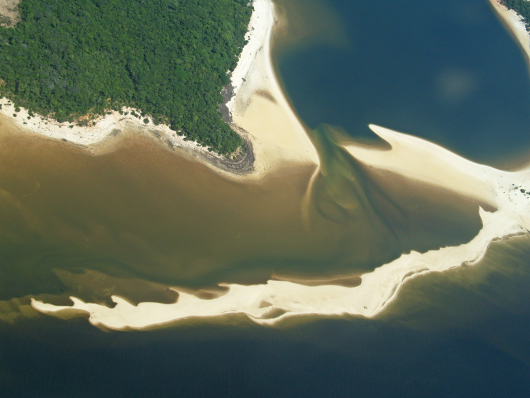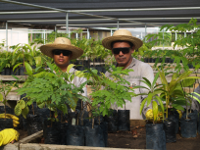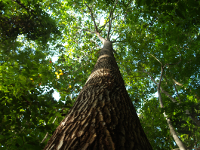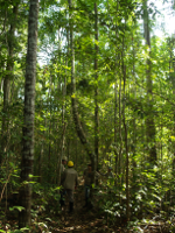Amazon Aluminium - Restoring the Rainforest
28.08.13

Amazon beaches
Cruising at around 5,000 feet – I know this because I am sitting directly behind the pilot and am watching his every move over his shoulder – in a (very) small propeller plane, the early morning views are spectacular; the Amazon river near Santarem, approaching 60 kilometres wide at this point, divides into a maze of channels and islands. Islands are painted every shade of green, shedding swirling, early mist like smoke. Some are forested with white sandy beaches, such that you could be forgiven for believing you might be in the Caribbean. I become alarmed and think we may be lost when the pilot unfolds a road map; but instead of navigating by it, he places it over the windscreen to eclipse the blinding sun – good move – but I now wonder how he can see where we’re going!
Brazil has determined that its vast natural resources should be exploited to help lift its citizens out of poverty. Its rapidly growing mining industry operates across the Amazon extracting metals and minerals for Brazilian and global society. The typical image of mining in the Amazon is of thousands of artisanal miners (garimpeiros) scraping gold and gemstones from the harsh earth and causing environmental and human damage. While such scenes do exist, the real national wealth from Brazilian mining is produced by some of the biggest mines in the world.
This being the Amazon there is a great deal of environmental sensitivity around mining and some of the biggest players, including the giant MRN Trombetas and ALCOA Juruti aluminium mines that I am here to see, have respectable reputations for their corporate responsibility agendas and carry out world class rainforest restoration work.
It is this internationally renowned forest landscape work that I have come to see as part of a two-month sabbatical to “explore world class landscape restoration” – a subject that fits with my personal interests as well as my profession as an international mining environmental and social consultant with Wardell Armstrong International. By landscape restoration I mean, the improvement of degraded land on a large scale that rebuilds ecological integrity and enhances people’s lives.
Kindly supported by the UK’s Winston Churchill Memorial Trust, my two-month landscape restoration odyssey is taking me from the mountain-top removal coal mines of Appalachia to the southern tip of South America via the Everglades, Costa Rica, Galapagos Islands, the Atlantic Rainforest region of south-east Brazil, mines in the Amazon and farmlands and logged forests in Chilean and Argentine Patagonia.
Snap back to reality! We are descending to a short, red dirt airstrip, surrounded by towering jungle trees rising rapidly to meet us; I need to check that the pilot is doing his job properly!
I am met at the airport then driven into the jungle. After half an hour or so, we emerge from the forest road into an expansive moonscape, distantly bordered by the green wall of jungle. Weaving around the mechanical dinosaurs of the mining industry, we bump along the dirt roads of an earthen scar under a bleached blue sky, heaps of yellow and red rock towering over us. We arrive on the other side of the experience back on the edge of the Amazon jungle – or at least it had been the edge a few days ago! Now the forest is almost flattened; enormous trunks lie scattered randomly like dropped matchsticks as chainsaw rasping reverberates incessantly in the distance.

Amazon bauxite mining panorama
Both mines strip-mine the huge bauxite deposits just a few metres below the roots of the rainforest. From above, the mining areas form almost perfect red rectangles cut from the green forest blanket, which is impressively visible on Google Earth. First the forest is cleared with commercial timber stockpiled until authorisation is received for its transportation. Then the topsoil (about 50 cm thick) and overburden (8-12m thick) are separately scraped off and stockpiled for later use in reclamation, revealing the red bauxite below, which is excavated and taken for subsequent processing and export. This is then covered with the topsoil and is subsequently planted with rainforest tree seedlings. Progressive restoration with tree seedlings is carried out as the earth is stripped at one end of the operation it is replaced at the back end, covered with translocated topsoil and then planted with seedlings.
MRN’s Trombetas mine is located on the Trombetas tributary of the Amazon River and is the largest aluminium mine in the world. Mining began in the 1970s when there was little here but rainforest and small, scattered communities. Today there is an enormous surface mine and a mining town of a few thousand people, which are surrounded by the Saracá-Taquera National Forest protected area. There is a legal requirement to restore the forest – which has been underway since 1984 and had, to 2011, planted nine million trees over 4,500 hectares to re-create high biodiversity rainforest. ALCOA’s Juruti mine, which is on the south side of the Amazon, is a similar bauxite deposit of an estimated 700 million tonnes of ore, but the development is much newer, with mining only beginning in the last couple of years, and with a potential mine life that will take us towards the end of this century.
The process of rainforest restoration actually begins before mineral extraction starts. Wildlife monitoring is set-up two-years before and continues during forest clearance. We are here to see the rescue team in action, whose job is to scour the forest before clearance to remove slow-moving animals and save important plant specimens. Employing trained local contractors, the team rescues slow-moving animals, such as sloths and tortoises, important plant species such as orchids and the nests of stingless bees, which are vital for the pollination of many forest plants, including trees. These are translocated to previously restored forest areas. I am shown a large wooden box the size of a tea chest, upon which sits a smaller wooden box bound tightly with rope. The occupant of the latter is colloquially called sururucu - a three-metre long, venomous snake! The rescue chaps start opening the box to offer us a closer look, but I am more than satisfied to simply watch a video of the beast’s capture on a mobile phone. (Sururucu will be sent to a snake research organisation in Belem, which will then return it to a safer patch of forest.) If that’s what's in the small box, then the occupant of the larger one must be truly terrifying! Despite my protestations they open it and lift out a sleepy, three-toed sloth that slowly gazes around with a bizarrely high-foreheaded human face and a fixed smile! Nearby, under a temporary awning, is a motley collection of smaller animals – lizards, frogs, etc. and tree seedlings that have been carefully extracted from the forest before their parents become flattened.
The ultimate goal of the restoration team is to regrow the jungle as close to the original as possible. Working in collaboration with a range of Brazilian scientific institutions, Trombetas has been researching how best to do this for over 30 years, based on a systematic nursery and field research strategy. Since 1997 about 50 Masters’ theses and 25 PhD theses have investigated the developing ecology of these forests. Juruti, on the other hand, only began mining in the past couple of years and is adapting and building on the generation of Trombetas’ forest restoration knowledge.

Nursery
At Trombetas, of the 180 tree species found in the local forest, about 100 are chosen for replanting based on their speed of growth for soil protection, their ability to attract animals (through fruit and flower production) that import seeds from outside the area; and use to people – fruit and nut production, medicinal use, timber, etc. Around Juruti the jungle contains about 460 tree species, of which currently only 30 - mainly pioneer – species are planted in the restoration schemes.
A favourite species, for economic reasons, is the Brazil nut tree. At Trombetas, twelve local village families assist in collecting seeds and raising seedlings to augment the half a million produced every year by MRN’s own nursery. Around 70 local people are employed to plant the trees during the wet season.

30 year old Brazil nut tree
The Trombetas restoration work has provided the template for Juruti’s approach and there is a great deal of cross-over. Both mines, working with Brazilian forest scientists, are refining their rehabilitation practices. The latest initiative involves loose-tipping translocated topsoil off the backs of trucks and leaving it un-compacted. The regular rain of the area washes these piles down to cover the surrounding subsoil into which trees are then planted. This method requires fewer heavy vehicle movements (because no spreading is involved) thus reducing compaction (therefore improving tree establishment), saving fuel costs and reducing greenhouse gas emissions. The different soil depths also provide more ecological niches for colonisation by other species.
Although this hot, wet and humid climate is not ideal for someone from the north of England it does provide excellent conditions for growing a new jungle! At Juruti I am shown a small pilot area where trees planted less than three years ago and are already double my height and the shade-inducing canopy is closing. This means light-loving weeds are shaded out and forest understorey plants can gain a toe-hold. New trees are coming in, spread in the guts of animals attracted to the newly planted forest areas, and slowly the rainforest recreates its own self-supporting web of life.

30 year old restored forest
To the casual observer the Trombetas’ oldest planted areas are becoming indistinguishable from the rest of the forest, although the team are not satisfied as their numerous indicators of success suggest that it is only (!) around 70% there. I am shown the very first forest planted in the early 1980s, where the translocated stingless bee beehives are buzzing happily, epiphytes have been reintroduced from more recent cleared areas and a Brazil nut tree is already a 40-metre giant around which my gibbon-like my arms don’t reach even half-way. The Brazil nut tree, which produces
those famously hard nuts, is economically important to Amazon rainforest dwellers who harvest the nuts for our Christmas delectation. Owing to its complicated ecology, the tree does not do well in plantations and will only grow in areas of standing rainforest. During restoration the tree species mix is subtly adapted to enhance long-term socio-economic opportunities for local people, whilst rebuilding the forests ecological integrity.
My instinctive sadness to the destruction of these wonderfully uncomfortable and stimulating jungle places is balanced by the uplifting effort expended by genuinely concerned, talented people to regrow the forests and provide new opportunities for people in a rapidly changing world.
Dr. Peter Whitbread-Abrutat
Further information
|